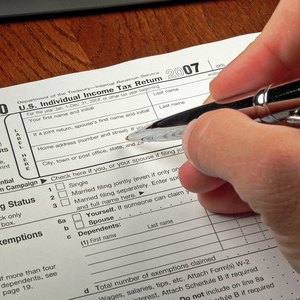
Individual retirement accounts provide tax benefits that encourage long-term savings. A custodian must administer your IRAs, and you and your custodian share tax-reporting duties. One such duty is to report an IRA distribution, even if it was returned within 60 days or otherwise rolled over. You need to be familiar with a few Internal Revenue Service forms to satisfy the agency’s tax reporting requirements.
Read More: How to Report IRA Rollovers
IRA Distribution Returned Within 60 Days
When you withdraw money from your traditional IRA, you begin a 60-day countdown to protect the money from immediate taxation. You can do so by rolling over the money to a different traditional IRA (or retuning the money to the original IRA) within 60 days. If you miss the deadline, you’ll have to include the withdrawn amount in your current taxable income. If you are under age 59 ½, you might also have to pay a 10 percent penalty for an early withdrawal, although some exceptions exist.
The two main IRS forms involved with reporting rollover transactions are Form 1099-R and Form 5498.
Basics of Form 1099-R
Your custodian will provide you and the IRS with Form 1099-R detailing your IRA distributions for the previous year. The form features a code that describes the distribution.
Different code values indicate whether it is a normal or early distribution. The code also reports whether or not an early distribution qualifies as a tax-free rollover and any exceptions to the 10 percent penalty on money withdrawn before age 59 1/2. If you have a rollover IRA, the form will use a special distribution code for direct rollovers and rollover contributions.
Read More: What If a 1099-R Is Incorrect?
Basics of Form 5498
Form 5498 reports your IRA contributions and rollovers for the year. Your custodian prepares this form for you and the IRS. The form reports regular contributions, rollovers, Roth conversions, recharacterized contributions and year-end fair market values.
Read More: Do I Report an IRA Fair Market Value on Tax?
Form 5498 helps the IRS determine that you properly rolled over a distribution reported on Form 1099-R and is thus free of taxes and penalties. The form also reports whether required distributions are due for the year. Traditional IRAs require minimum distributions after you reach age 72.
Additional Taxes on Distributions
An IRA owner uses Form 5329 to report distributions subject to the 10 percent penalty for early withdrawals. Use the form to calculate the penalty amount. You may be slapped with this penalty if you miss the 60-day rollover deadline.
You can also use the form to report distributions that are exempt from the penalty. This is especially important when your custodian reports the wrong distribution code on Form 1099-R. Form 5329 has other sections to report the tax on excess contributions to traditional and to Roth IRAs. The penalty tax rate rises to 50 percent for required distributions you fail to take. Report these in the final section of Form 5329.
Considerations for Nondeductible IRAs
Use Form 8606 to report nondeductible contributions and distributions. Nondeductible distributions are tax-free, because you’ve already paid the taxes on the money. You can create a nondeductible contribution to a traditional IRA when you or your spouse belongs to a qualified employer plan and your income exceeds IRS limits, which change yearly.
You must prorate nondeductible contributions when you withdraw money from a traditional IRA so that you don’t double-pay taxes on the prorated amount. Be very careful to properly report rollovers or refunds of nondeductible contributions or you might have to pay taxes again on the money when you later withdraw it.
References
Warnings
- If you did not contribute 100 percent of the amount distributed from your IRA (including the amount withheld for taxes), the "gross distribution" and "rollover contribution" amounts won't match, and the difference will be taxable.
- Consult a tax adviser regarding any tax implications that could result from not complying with the 60-day rollover rule.
Writer Bio
Eric Bank is a senior business, finance and real estate writer, freelancing since 2002. He has written thousands of articles about business, finance, insurance, real estate, investing, annuities, taxes, credit repair, accounting and student loans. Eric writes articles, blogs and SEO-friendly website content for dozens of clients worldwide, including get.com, badcredit.org and valuepenguin.com. Eric holds two Master's Degrees -- in Business Administration and in Finance. His website is ericbank.com.

